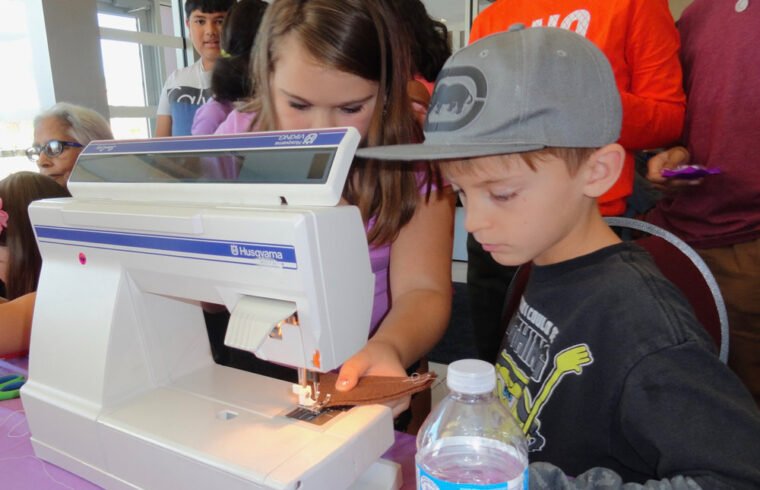Learning to sew is a valuable skill that opens up a world of creative possibilities. Whether you want to mend clothes, create custom garments, or explore a new hobby, sewing offers both practical benefits and personal satisfaction. This guide will walk you through the essentials of sewing, from understanding the basics to tackling simple projects and maintaining your sewing machine. By the end, you’ll have a solid foundation to start your sewing journey and gain confidence in your new skill.
Understanding Sewing Basics
What is Sewing?
Sewing is the process of joining fabric pieces together using a needle and thread. This technique has been around for centuries and is fundamental in creating clothing, accessories, and home décor. The beauty of sewing lies in its versatility; it allows you to customize and repair items, making it a practical and creative skill. Whether you’re looking to make your own clothes or simply fix a tear in your favorite shirt, learning to sew can be both enjoyable and rewarding.
Essential Sewing Tools and Supplies
To get started with sewing, you’ll need a few basic tools. A sewing machine is essential, but you’ll also need a variety of other supplies. These include needles, thread, fabric, scissors, pins, and measuring tape. Additionally, having a seam ripper on hand is useful for correcting mistakes. For beginners, a basic sewing kit with these essentials will suffice. As you progress, you might expand your toolkit with specialized tools, but starting with the basics will help you become familiar with sewing techniques and materials.
Types of Fabrics and Their Uses
Fabric choice is crucial in sewing, as different fabrics have different characteristics and uses. Cotton is a popular choice for beginners due to its ease of handling and versatility. It’s great for making shirts, dresses, and home décor items. Polyester and blends are durable and often used for clothing that requires less maintenance. For more advanced projects, you might explore fabrics like silk or wool, each offering unique textures and challenges. Understanding fabric types and their properties will help you select the right material for your projects and achieve better results.
Getting Started with Sewing
How to Choose the Right Sewing Machine
Selecting a sewing machine can be daunting for beginners, but focusing on a few key features can simplify the process. Start with a machine that offers basic stitches and easy-to-use controls. A machine with adjustable stitch length and width is versatile and suitable for various projects. Consider a model with a built-in needle threader and automatic bobbin winding for convenience. As you gain experience, you can explore more advanced machines with additional features. Investing in a reliable machine will make your sewing journey smoother and more enjoyable.
Basic Sewing Stitches and Techniques
Before diving into projects, it’s important to learn some fundamental sewing stitches. The straight stitch is the most basic and is used for most seams. The zigzag stitch helps prevent fabric edges from fraying and is useful for finishing seams. The backstitch provides extra strength for areas that need durability. Practice these stitches on scrap fabric to build your confidence. Learning these basics will set a strong foundation for more complex techniques and projects, allowing you to sew with greater precision and skill.
Understanding Patterns and Instructions
Sewing patterns are templates that guide you in cutting fabric and assembling pieces. Patterns come with instructions that outline each step of the sewing process. It’s important to read through the instructions carefully before starting a project. Patterns often include markings that help you align fabric pieces correctly. Familiarize yourself with pattern symbols and terminology to ensure you follow the instructions accurately. Understanding patterns will help you create garments and projects that fit well and look professional.
Practical Sewing Projects for Beginners
Simple Projects to Start With
Starting with simple projects helps beginners build confidence and skills. A pillowcase is a great first project as it requires basic sewing techniques and is quick to complete. A tote bag is another beginner-friendly project that allows you to practice cutting, sewing, and finishing seams. Both projects offer a chance to learn and practice essential sewing skills while creating useful items. As you become more comfortable, you can experiment with more complex designs and techniques.
Step-by-Step Guides for Each Project
For each beginner project, following a step-by-step guide can simplify the process. For a pillowcase, start by cutting two pieces of fabric to the desired size.Learn to sew the pieces together, leaving an opening for turning and inserting the pillow. For a tote bag, cut out fabric pieces for the main body and handles. Assemble the bag by sewing the sides and adding handles. Detailed instructions for each project will help you understand the sewing process and build your skills incrementally.
Tips for Troubleshooting Common Mistakes
Mistakes are a natural part of learning to sew. Common issues include uneven stitches, fabric puckering, and misaligned seams. To address these problems, ensure your sewing machine is properly threaded and adjusted. Use the correct needle and thread for your fabric type. Practice on scrap fabric to troubleshoot and refine your technique. If you encounter specific issues, consult sewing guides or seek advice from experienced sewers. Troubleshooting and problem-solving are important skills that will help you improve and enjoy sewing.
Developing Sewing Skills
How to Improve Your Sewing Technique
Improving your sewing technique involves practice and learning new skills. Regularly work on different projects to build your confidence and expertise. Experiment with various stitches, fabrics, and sewing methods to expand your abilities. Watching online tutorials or taking sewing classes can provide additional guidance and tips. Joining a sewing group or community can offer support and inspiration. Consistent practice and a willingness to learn will help you advance from a beginner to a more skilled sewer.
Learning Advanced Stitches and Techniques
As you gain experience, exploring advanced stitches and techniques can enhance your sewing projects. Techniques such as embroidery, applique, and quilting add decorative elements and complexity to your creations. Advanced stitches like the French seam or welt pocket provide professional finishes to garments. Investing time in learning these techniques will enable you to tackle more challenging projects and create high-quality, unique items. Many resources, including books and online courses, are available to help you master advanced sewing skills.
Resources for Further Learning
To continue developing your sewing skills, take advantage of various learning resources. Online tutorials, video demonstrations, and sewing blogs offer valuable insights and tips. Many websites and YouTube channels provide step-by-step instructions and troubleshooting advice. Sewing classes, both online and in-person, can provide structured learning and hands-on experience. Libraries and bookstores also offer a range of sewing books that cover techniques, patterns, and project ideas. Utilizing these resources will support your growth as a sewer and keep you motivated.
Maintaining Your Sewing Machine
Basic Maintenance Tips
Proper maintenance of your sewing machine ensures its longevity and optimal performance. Regularly clean your machine by removing dust and lint from the bobbin area and feed dogs. Oil the machine according to the manufacturer’s instructions to keep it running smoothly. Change the needle regularly, especially when working with different fabrics. Follow the maintenance schedule in your machine’s manual and address any issues promptly to avoid larger problems. Keeping your machine in good condition will help you achieve better sewing results and extend its lifespan.
How to Troubleshoot Common Machine Issues
Troubleshooting sewing machine issues can help you resolve problems quickly and keep your projects on track. Common issues include thread tangles, skipped stitches, and needle breakage. Check the threading of the machine and ensure the needle is correctly installed. Adjust the tension settings if you experience uneven stitches. If the machine is making unusual noises or not sewing properly, consult the user manual for troubleshooting tips. Regular maintenance and prompt troubleshooting will help you avoid disruptions in your sewing projects.
When to Seek Professional Repairs
While basic maintenance can be handled at home, some issues may require professional repair. If your machine has persistent problems despite troubleshooting, or if it’s showing signs of mechanical failure, seek assistance from a qualified technician. Professional repairs are especially important for issues like motor malfunctions or intricate internal problems. Regular servicing by a professional can also help maintain your machine’s performance and prevent future issues. Knowing when to seek expert help ensures your sewing machine remains in optimal working condition.
Conclusion
Learning to sew is a fulfilling and practical skill that enhances your creativity and problem-solving abilities. By starting with basic techniques and gradually taking on more complex projects, you can develop your sewing skills and create beautiful, customized items. Remember to practice regularly, explore different techniques, and utilize available resources to continue improving. Sewing not only provides a sense of accomplishment but also opens up endless possibilities for personal expression. Embrace the learning process and enjoy the journey of becoming a skilled sewer.











